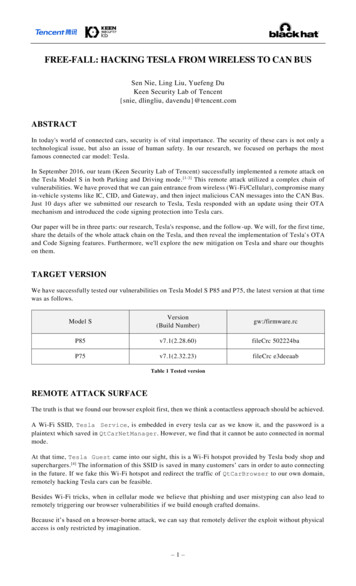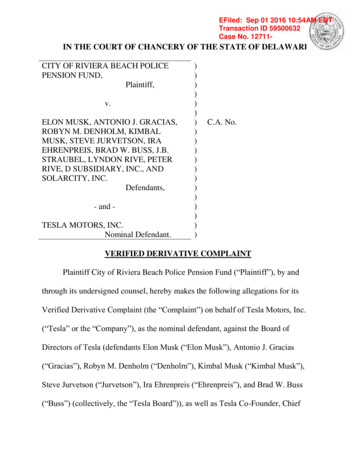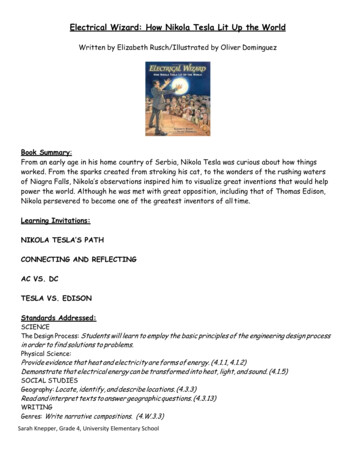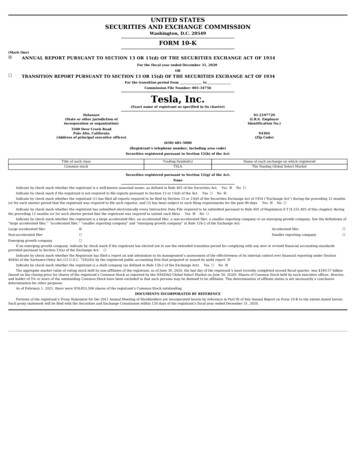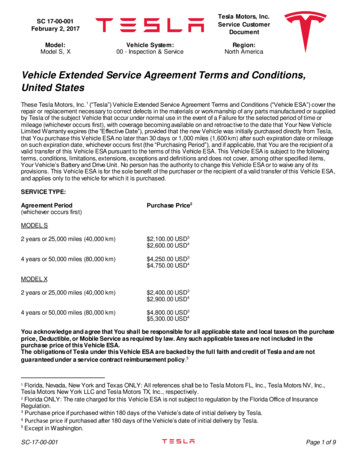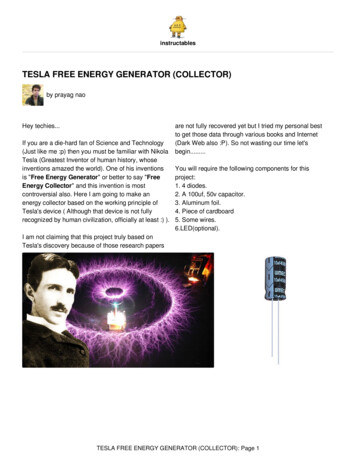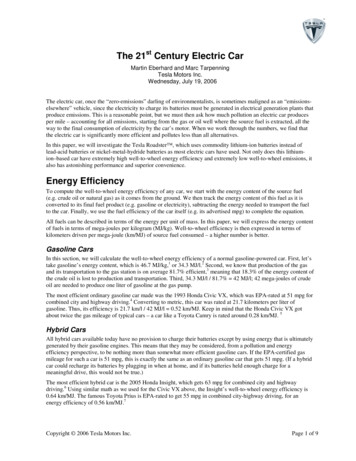
Transcription
The 21st Century Electric CarMartin Eberhard and Marc TarpenningTesla Motors Inc.Wednesday, July 19, 2006The electric car, once the “zero-emissions” darling of environmentalists, is sometimes maligned as an “emissionselsewhere” vehicle, since the electricity to charge its batteries must be generated in electrical generation plants thatproduce emissions. This is a reasonable point, but we must then ask how much pollution an electric car producesper mile – accounting for all emissions, starting from the gas or oil well where the source fuel is extracted, all theway to the final consumption of electricity by the car’s motor. When we work through the numbers, we find thatthe electric car is significantly more efficient and pollutes less than all alternatives.In this paper, we will investigate the Tesla Roadster , which uses commodity lithium-ion batteries instead oflead-acid batteries or nickel-metal-hydride batteries as most electric cars have used. Not only does this lithiumion–based car have extremely high well-to-wheel energy efficiency and extremely low well-to-wheel emissions, italso has astonishing performance and superior convenience.Energy EfficiencyTo compute the well-to-wheel energy efficiency of any car, we start with the energy content of the source fuel(e.g. crude oil or natural gas) as it comes from the ground. We then track the energy content of this fuel as it isconverted to its final fuel product (e.g. gasoline or electricity), subtracting the energy needed to transport the fuelto the car. Finally, we use the fuel efficiency of the car itself (e.g. its advertised mpg) to complete the equation.All fuels can be described in terms of the energy per unit of mass. In this paper, we will express the energy contentof fuels in terms of mega-joules per kilogram (MJ/kg). Well-to-wheel efficiency is then expressed in terms ofkilometers driven per mega-joule (km/MJ) of source fuel consumed – a higher number is better.Gasoline CarsIn this section, we will calculate the well-to-wheel energy efficiency of a normal gasoline-powered car. First, let’stake gasoline’s energy content, which is 46.7 MJ/kg,1 or 34.3 MJ/l.2 Second, we know that production of the gasand its transportation to the gas station is on average 81.7% efficient,3 meaning that 18.3% of the energy content ofthe crude oil is lost to production and transportation. Third, 34.3 MJ/l / 81.7% 42 MJ/l; 42 mega-joules of crudeoil are needed to produce one liter of gasoline at the gas pump.The most efficient ordinary gasoline car made was the 1993 Honda Civic VX, which was EPA-rated at 51 mpg forcombined city and highway driving.4 Converting to metric, this car was rated at 21.7 kilometers per liter ofgasoline. Thus, its efficiency is 21.7 km/l / 42 MJ/l 0.52 km/MJ. Keep in mind that the Honda Civic VX gotabout twice the gas mileage of typical cars – a car like a Toyota Camry is rated around 0.28 km/MJ. 5Hybrid CarsAll hybrid cars available today have no provision to charge their batteries except by using energy that is ultimatelygenerated by their gasoline engines. This means that they may be considered, from a pollution and energyefficiency perspective, to be nothing more than somewhat more efficient gasoline cars. If the EPA-certified gasmileage for such a car is 51 mpg, this is exactly the same as an ordinary gasoline car that gets 51 mpg. (If a hybridcar could recharge its batteries by plugging in when at home, and if its batteries held enough charge for ameaningful drive, this would not be true.)The most efficient hybrid car is the 2005 Honda Insight, which gets 63 mpg for combined city and highwaydriving.6 Using similar math as we used for the Civic VX above, the Insight’s well-to-wheel energy efficiency is0.64 km/MJ. The famous Toyota Prius is EPA-rated to get 55 mpg in combined city-highway driving, for anenergy efficiency of 0.56 km/MJ.7Copyright 2006 Tesla Motors Inc.Page 1 of 9
Electric CarsEven with tires and gearing optimized for performance (rather that absolute efficiency), the Tesla Roadster onlyconsumes about 110 watt-hours (0.40 mega-joules) of electricity from the battery to drive a kilometer, or 2.53km/MJ.The energy cycle (charging and then discharging) of the lithium-ion batteries in the Tesla Roadster is about 86%efficient.8 This means that for every 100 mega-joules of electricity used to charge such a battery, only 86 megajoules of electricity are available from the battery to power the car’s motor. Thus, the “electrical-outlet-to-wheel”energy efficiency of the Tesla Roadster is 2.53 km/MJ x 86% 2.18 km/MJ.The most efficient way to produce electricity is with a “combined cycle” natural gas-fired electric generator. (Acombined cycle generator combusts the gas in a high-efficiency gas turbine, and uses the waste heat of this turbineto make steam, which turns a second turbine – both turbines turning electric generators.) The best of thesegenerators today is the General Electric “H-System” generator, which is 60% efficient,9 which means that 40% ofthe energy content of the natural gas is wasted in generation.Natural gas recovery is 97.5% efficient, and processing is also 97.5% efficient.10 Electricity is then transportedover the electric grid, which has an average efficiency of 92%,11 giving us a “well-to-electric-outlet” efficiency of60% x 92% x 97.5% x 97.5% 52.5%.Taking into account the well-to-electric-outlet efficiency of electricity production and the electrical-outlet-towheel efficiency of the Tesla Roadster, the well-to-wheel energy efficiency of the Tesla Roadster is 2.18 km/MJ x52.5% 1.14 km/MJ, or double the efficiency of the Toyota Prius.12Hydrogen Fuel-Cell CarsHydrogen does not exist in nature except as part of more complex compounds such as natural gas (CH4) or water(H2O). The most efficient way to produce large quantities of hydrogen today is by reforming natural gas. For newplants, the well-to-tank efficiency of hydrogen produced from natural gas, including generation, transportation,compression, is estimated to be between 52% and 61% efficient.13The upper limit of efficiency for a PEM fuel cell is 50%14. The output of the fuel cell is electricity for turning adrive motor, and we can assume the same 2.78 km/MJ vehicle efficiency as with the electric car. With thesenumbers, we can calculate the well-to-wheel energy efficiency for our hydrogen fuel-cell car: 2.78 km/MJ x 50% x61% 0.85 km/MJ.This is impressive when compared to a gasoline car, though it is 32% worse than our electric car. But real fuel-cellcars do not perform nearly this well. Several car companies have produced a small number of demonstration fuelcell cars, and the EPA has rated the efficiency of some of these. The best fuel-cell demonstration car measured bythe EPA is the Honda FCX, which gets about 49 miles per kilogram of hydrogen,15 equal to 80.5 kilometers perkilogram.We know that the energy content of hydrogen is 141.9 MJ/kg,16 so we can calculate the vehicle efficiency to be80.5 km/kg / 141.9 MJ/kg 0.57 km/MJ. (Clearly, the Honda fuel cell is nowhere near the theoretical 50%efficiency assumed above.) When we calculate the well-to-wheel energy efficiency of this Honda experimentalcar, we get 0.57 km/MJ x 61% 0.35 km/MJ, not even as good as the ordinary diesel Volkswagen Jetta, let alonethe gasoline-powered Honda Civic VX or the Honda Insight hybrid car.However, some proponents of hydrogen fuel cells argue that it would be better to produce hydrogen throughelectrolysis of water. The well-to-tank efficiency of hydrogen made through electrolysis is only about 22%,17 andthe well-to-wheel energy efficiency of our theoretical fuel-cell car would be 2.78 km/MJ x 50% x 22% 0.30km/MJ, and the well-to-wheel energy efficiency of the Honda FCX would be 0.57 km/MJ x 22% 0.12 km/MJ,even less efficient than a Porsche Turbo.Even with the 1.2 billion U.S. government initiative to reduce U.S. dependence on foreign oil by developinghydrogen-powered fuel cells, a recent report by a panel at the National Academy of Sciences shows thatAmericans should not hold their breath waiting for the cars to arrive in showrooms.Page 2 of 9Copyright 2006 Tesla Motors Inc.
"In the best-case scenario, the transition to a hydrogen economy would take many decades, and any reductions inoil imports and carbon dioxide emissions are likely to be minor during the next 25 years," said the Academy.18ComparisonThe following table shows the well-to-wheel energy efficiency of several types of high-efficiency cars – includingan efficiency estimate of the Tesla Roadster – based on the measured performance prototypes.003 45*6-7! " # %" . # %2 #. %! . #( %! . #( %' ,#' %11181.4&'" / *)' '."&. *) #& ( #' ( #' & #" & #( !,#. !))))))****** #& , ) #& ' ) #/ ! ) #' . ) #" / ). #. / )****** Well-to-Wheel Energy .51VW JettaDieselHonda CivicVX0.640.0Honda CNG Honda FCXHondaInsightTeslaRoadsterEmissionsBurning fuel produces a variety of emissions, including sulfur, lead, unburned hydrocarbons, carbon dioxide, andwater. Through the years, we have improved the emissions of both cars and power plants by reformulating thefuels to eliminate sulfur and metals, and by improving combustion and post-combustion scrubbing to eliminateunburned hydrocarbons. In the end, an ideal engine or power plant will only emit carbon dioxide and water. Wateris fine, but carbon dioxide is the greenhouse gas that cannot be avoided.We can compute the well-to-wheel carbon dioxide emissions for a given vehicle in a way similar to how wecomputed energy efficiency, since we know the carbon content of the source fuel. With perfect combustion, all ofthe carbon in the source fuel will eventually become carbon dioxide. Assuming perfect combustion, we cancalculate the “CO2 content” of any source fuel. Crude oil has a CO2 content of 0.07164 grams per watt-hour, andnatural gas has a CO2 content of 0.05184 grams per watt-hour.19With these numbers, we can calculate the well-to-wheel emissions of the various vehicles, based on the carboncontent of the source fuel and the energy efficiency of the vehicles:Copyright 2006 Tesla Motors Inc.Page 3 of 9
1003 45*6-7. / #/. / #/. 2 #2. 2 #2. 2 #2. / #/111850451,****** #& , ) #& ' ) #/ ! ) #' . ) #" / ). #. / )******, / ' # / . #./ . #'& 2 # & . #. ,#"*)*)*)*)*)*)Well-to-Wheel Carbon Dioxide Emissions403530g/km 252045.041.141.539.031.1151012.650Honda CNGHonda FCXVW JettaDieselHonda CivicVXHondaInsightTeslaRoadsterAgain, the electric car shines – from the perspective of CO2 emissions, it is three times better than the hybrid car,and nearly four times better than the hydrogen fuel-cell car.The True Multi-Fuel CarThe beauty of powering cars with electricity from the grid is that we can generate the electricity any way we wantwithout changing the cars. As we have seen, we can generate electricity with our choice of fossil fuels. We canalso use nuclear fuel, or we can generate it with any of a number of “green” sources, such as hydroelectric,geothermal, wind, solar, or biomass. Electricity is the universal currency of energy, and we already have acomprehensive distribution system for it.Proponents of hydrogen fuel-cell cars regularly compare the forecasted best efficiency of hydrogen production andconversion – in futuristic plants and fuel cells that have never been built – to the efficiency of the average existingelectric generation plant – including all those 25% to 30% efficient power plants that were built in the 1950s. Thisis not a fair comparison – if we are willing to build all-new hydrogen production plants to power a hydrogen carfuture, then we should be just as willing to build new electric generators to power an electric car future. We haveassumed 60% efficient best-of-breed electric generators, but not science-fiction electric generators.However, natural gas accounts for only 14.9%20 of U.S. electricity generation; the rest is a mix of coal, nuclear,and others. The average well-to-outlet efficiency of U.S. electric generation, including all the old, inefficientpower plants, is about 41%.21 With this efficiency, our electric car has a well-to-wheel energy efficiency of 0.83km/MJ, still the most efficient car on the road.Of course, fuel-cell cars are also multi-fuel cars, since hydrogen can be produced from water using electricity fromany source. But this is a very inefficient way to use electricity. Consider the following chart:Page 4 of 9Copyright 2006 Tesla Motors Inc.
Battery Electric CarGrid-to-Motor Efficiency 86%Electricityfrom GridChargerLi-ion Battery93% efficient93% efficientHydrogen ProductionInverter &Electric Motorin CarFuel-Cell CarGrid-to-Motor Efficiency 25%Electricityfrom GridH2O ElectrolysisH2 CompressorH2 Fuel Cell70% efficient90% efficient40% efficientInverter &Electric Motorin CarIt is obvious that when we start with electricity (however it is produced), it is hard to beat the 86% efficiency ofthe currently available lithium-ion batteries and chargers. Even when we assume extremely high efficiencies forelectrolysis, compression, and the fuel cell, the fuel-cell car requires more than three times as much electricityfrom the grid to drive the same distance.PerformanceThe vision of replacing many of the cars on the road with clean commuter vehicles has caused most producers ofelectric cars to build low-end cars with as low a price as possible. But even if a solid argument could be made thatelectric cars will ultimately be cheaper than equivalent gasoline cars, they will certainly not be cheaper until theirsales volume approaches that of a typical gasoline car – many thousands per year at least.Until an electric car manufacturer achieves high enough sales to approach a gasoline car manufacturer’s volumeefficiencies, electric cars will need to compete on other grounds besides price. Aside from the obvious emissionsadvantage, there is another way that an electric car can vastly outperform a gasoline car – in a word, torque. Agasoline engine has very little torque at low rpm’s and only delivers reasonable horsepower in a narrow rpm range.On the other hand, an electric motor has high torque at zero rpm, and delivers almost constant torque up to about6,000 rpm, and continues to deliver high power beyond 13,500 rpm. This means that an electric car can be veryquick without any transmission or clutch, and the performance of the car is available to a driver without specialdriving skills.With a gasoline engine, performance comes with a big penalty – if you want a car that has the ability to acceleratequickly, you need a high-horsepower engine, and you will get poor gas mileage even when you are not driving ithard. On the other hand, doubling the horsepower of an electric motor from 100 hp to 200 hp only adds about 25pounds, and the efficiency is, if anything, improved. It is therefore quite easy to build an electric car that is bothhighly efficient and also very quick.At one end of the spectrum, the electric car has higher efficiency and lower total emissions than the most efficientcars. At the other end of the spectrum, the electric car accelerates at least as well as the best sports cars, but is sixtimes as efficient and produces one-tenth the pollution. The chart on the following page compares the TeslaRoadster with several high-performance cars and with several high-efficiency cars.Copyright 2006 Tesla Motors Inc.Page 5 of 9
185 4 "5 . ,65 !65/5/65/6*6045&6:. *),,# . . #(,' # ' . # ' # & ' # " & # " / *)4'' 3630 3-7-18. #. / ) #,, ) #. , ) #,' ) #' , ) #/ ! ) #& , ) #" / ) #& ' )********* 9, . ,#"" / #(. ,. #(' ( # ,( #2/ . #'/ ' # & . #,/ . #.*)*)*)*)*)*)*)*)*)" & #2/ #,/ #(/ #!2 #/. . # . ,# . ,#&. ' #!0 to 60 mph RoadsterPorscheTurboFerrari 550MaranelloChevroletCorvette211.012.012.3VW JettaDieselHonda CNGHondaInsight01.2Honda FCXWell-to-Wheel Energy Efficiency1.00.8km/MJ0.6Honda 400.12Ferrari 550Maranello0.520.48Honda CivicVXVW JettaDiesel0.25ChevroletCorvette0.640.350.32Honda CNG Honda Insight Honda FCXWell-to-Wheel Carbon Dioxide RoadsterPage 6 of 927.9PorscheTurboFerrari 550MaranelloChevroletCorvetteHonda CivicVX41.545.0VW JettaDieselHonda CNG31.2HondaInsight41.1Honda FCXCopyright 2006 Tesla Motors Inc.
When we plot well-to-wheel energy efficiency against acceleration, almost all cars fall along a curve that showsexactly what we expect: the better the performance, the worse the mileage.But there is one car that is way off the curve: the Tesla Roadster. This car is clearly based on a disruptivetechnology – it simultaneously offers great acceleration and high energy efficiency.0Tesla RoadsterPorsche Carrera GT02High PerformanceSports Cars3Lamborghini MurcielagoElectricSports CarsHigh MileageDodge Viper SRT-10Saleen S74Acceleration from 0 to 60 mph (sec)Porsche 911 Turbo CoupeFerrari Maranello6Chevrolet Corvette Z06Lotus Esprit V88Panoz Esperante:Nissan 350ZToyota Celica10Nissan MaximaFord TaurusHigh MileageCars12Toyota CamrySubaru Legacy14Honda Civic VXVW Jetta DieselHonda CNG (nat. gas)16Honda FCX (fuel cell)Honda Insight (hybrid)180.00.20.40.60.81.01.2Well-to-Wheel Energy Efficiency (km/MJ)Copyright 2006 Tesla Motors Inc.Page 7 of 9
ConvenienceThe fundamental trade-off in convenience with electric cars is the advantage of starting every day with a “fulltank” (and never visiting a gas station) versus inconvenient refueling on the road. While it is wonderful never tovisit a gas station, this would be a bad trade-off if the driving range was too short.Electric cars like the EV1 gained notoriety for their short, 60-mile driving ranges.22 In contrast, a typical gasolinecar can go more than 250 miles on a tank of gas. The main reason that we want to have 250-mile range on ourgasoline cars is not primarily because we want to drive 250 miles in a day, but rather because we don’t want to goto the gas station every day – a tank of gas should go about a week. From this perspective, the 60-mile range of theelectric car might be enough for a commuter car.But 60 miles is not enough for anything but the most basic commute. It is not uncommon to drive significantlymore than 60 miles in a day – often leaving directly from work and without any planning ahead. (For example, adrive from Silicon Valley to the Pebble Beach golf course is about 90 miles each direction.) Making mattersworse, the more fun a car is to drive, the more it will be driven. A sports car enthusiast may likely find a 60-milerange to be extremely restrictive.Lithium-ion batteries (such as those in most laptop computers) have three times the amount of charge capacity asthat of lead-acid batteries of the same physical size, and, at the same time, weigh substantially less. Additionally,lithium-ion batteries will last well over 100,000 miles, while lead acid batteries need to be replaced about every25,000 miles. The original AC Propulsion tzero (a prototype electric car) had lead-acid batteries, and (like theEV1) had a range of about 60 miles.23 However, the range of the same prototype car, when converted to lithiumion batteries had a range of more than 250 miles and weighed 500 pounds less. Because of the additional weight ofsafety systems such as airbags, and because of the additional rolling drag of performance tires, the Tesla Roadsterwill have a range closer to 200 miles.A 200-mile range is much more acceptable even for a sports car enthusiast. The only shortfall of such an electricsports car is the inability to take long trips, since there aren’t any recharging stations along the highways, and sinceit takes time to charge batteries.Until we develop a charging infrastructure (even one that only consists of simple 240-volt electrical outlets inconvenient places), electric cars are best suited for local driving – around 200 miles from home.24 This is prettymuch how sports cars are driven anyway: when it’s time to take a long trip, take your other car.Electric cars are mechanically much simpler than both gasoline cars and fuel-cell cars. There is no motor oil, nofilters, no spark plugs, no oxygen sensors. The motor has one moving part, there is no clutch, and the transmissionis much simpler. Due to regenerative braking, even the friction brakes will encounter little wear. The only servicethat a well-designed electric car will need for the first 100,000 miles is tire service and inspection.Breaking the CompromiseIt is now possible build an exceedingly quick lithium-ion powered electric sports car that looks good, handles well,and is a joy to drive, at a lower price than most high-performance sports cars. And yet, this car will be the mostfuel-efficient and least polluting car on the road. You can have it all.Page 8 of 9Copyright 2006 Tesla Motors Inc.
Notes1Well-to-Wheel Studies, Heating Values, and the Energy Conservation Principle, 29 October 2003, Ulf Bossel2Density of Gasoline from Pocket Ref, 3rd Edition, 2002, Thomas Glover, Page 6603Exhaust Emissions From Natural Gas Vehicles by NyLund & Lawson, page 27, and also Well-to-Tank EnergyUse and Greenhouse Gas Emissions of Transportation Fuels – North American Analysis, June 2001, by GeneralMotors Corporation, Argonne National Laboratory, BP, ExxonMobil, and Shell. Vol. 3, Page 594EPA mileage numbers from www.fuelefficiency.gov5EPA mileage numbers from www.fuelefficiency.gov6EPA mileage numbers from www.fuelefficiency.gov7EPA mileage numbers from www.fuelefficiency.gov8The AC Propulsion lithium-ion tzero charging system (the basis for the design of the Tesla Roadster chargingsystem) efficiency was confirmed by the judges at the 2003 Challenge Bibendum.9General Electric "H System" Combined cycle generator, model MS7001H/9001H, as installed in Cardiff, Wales,in Tokyo, Japan, and in Scriba, New York.10Well-to-Tank Energy Use and Greenhouse Gas Emissions of Transportation Fuels – North American Analysis,June 2001, by General Motors Corp., Argonne National Laboratory, BP, ExxonMobil, and Shell. Vol. 3, Page 4211ibid, Page 3312The Department of Energy has defined “Equivalent Petroleum Mileage” as 82,049 Watt-hours per gallon, whiledriving the electric vehicle over the same urban and highway driving schedules as are used to compute the EPAmileage for other cars, and taking into account charging efficiency. (See Code of Federal Regulations, Title 10,Section 474.3.) This calculation would lead to the dubious conclusion that our electric vehicle gets:82049 Wh/gal / ( (110 Wh/km x 1.8 mi/km) / 86%) 356 miles per gallon!13Well-to-Tank Energy Use and Greenhouse Gas Emissions of Transportation Fuels – North American Analysis,June 2001, by General Motors Corporation, Argonne National Laboratory, BP, ExxonMobil, and Shell. Vol. 3,Page 5914Efficiency of Hydrogen Fuel Cell, Diesel-SOFC-Hybrid and Battery Electric Vehicles, 20 October 2003, UlfBossel15EPA mileage numbers from www.fuelefficiency.gov16Well-to-Wheel Studies, Heating Values, and the Energy Conservation Principle, 29 October 2003, Ulf Bossel17Well-to-Tank Energy Use and Greenhouse Gas Emissions of Transportation Fuels – North American Analysis,June 2001, by General Motors Corp., Argonne National Laboratory, BP, ExxonMobil, and Shell. Vol. 3, Page 5918Reuters, February 4, 2004, 5:50 PM19http://bioenergy.ornl.gov/papers/misc/energy conv.html20Well-to-Tank Energy Use and Greenhouse Gas Emissions of Transportation Fuels – North American Analysis,June 2001, by General Motors Corp., Argonne National Laboratory, BP, ExxonMobil, and Shell. Vol. 3, Page 4421ibid, Page 5922General Motors EV1 specifications from 24Most RV campsites have suitable 240-volt outlets, and can be used for charging on the road today. See, forexample, www.koa.com.Copyright 2006 Tesla Motors Inc.Page 9 of 9
consumes about 110 watt-hours (0.40 mega-joules) of electricity from the battery to drive a kilometer, or 2.53 km/MJ. The energy cycle (charging and then discharging) of the lithium-ion batteries in the Tesla Roadster is about 86% efficient.8 This means that for every 100 mega-joules of electricity used to charge such a battery, only 86 mega-

